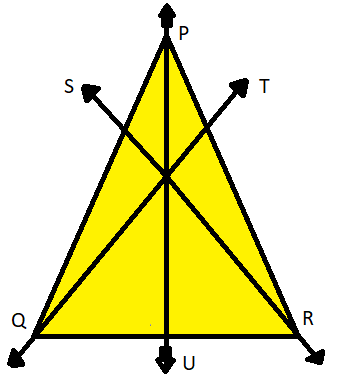
How many lines of symmetry are in this isosceles triangle?

$\left( a \right)$ 1
$\left( b \right)$ 2
$\left( c \right)$ 3
$\left( d \right)$ 4

Answer
581.4k+ views
Hint: In this particular question use the concept that line of symmetry divides any shape into two equal halves for example a square has two lines of symmetry, so use these concepts to reach the solution of the question.
Complete step by step answer:
Now as we know that line of symmetry divides any shape into two equal halves.
Isosceles triangle
An isosceles triangle is a triangle in which any of the lengths of two sides are equal and the length of the third side is different from the other two sides.
In an isosceles triangle opposite angles corresponding to similar sides are equal, and the opposite angle corresponding to different sides is different from the other two angles.
But the sum of all the angles remains 180 degrees.
So in an isosceles triangle if we draw the perpendicular from the intersection of sides which have the same length so the triangle is divided into two equal parts.
So in the above given isosceles triangle, draw the perpendicular from P on QR which cuts the QR on point U as shown in the given figure, so PUQ and PUR are two equal half’.
Now as QT and RS are not the perpendicular bisectors, so it does not divide the triangle into two equal halves.
So can say that the given isosceles triangle has one 1 line of symmetry which is PU.
So, the correct answer is “Option a”.
Note: Whenever we face such types of questions the key concept we have to remember that an equilateral triangle has 3 line of symmetry, an isosceles triangle has 1 line of symmetry and a scalene triangle (I.e. length of all sides are unequal) has no line of symmetry.
Complete step by step answer:
Now as we know that line of symmetry divides any shape into two equal halves.
Isosceles triangle
An isosceles triangle is a triangle in which any of the lengths of two sides are equal and the length of the third side is different from the other two sides.
In an isosceles triangle opposite angles corresponding to similar sides are equal, and the opposite angle corresponding to different sides is different from the other two angles.
But the sum of all the angles remains 180 degrees.
So in an isosceles triangle if we draw the perpendicular from the intersection of sides which have the same length so the triangle is divided into two equal parts.
So in the above given isosceles triangle, draw the perpendicular from P on QR which cuts the QR on point U as shown in the given figure, so PUQ and PUR are two equal half’.
Now as QT and RS are not the perpendicular bisectors, so it does not divide the triangle into two equal halves.
So can say that the given isosceles triangle has one 1 line of symmetry which is PU.
So, the correct answer is “Option a”.
Note: Whenever we face such types of questions the key concept we have to remember that an equilateral triangle has 3 line of symmetry, an isosceles triangle has 1 line of symmetry and a scalene triangle (I.e. length of all sides are unequal) has no line of symmetry.
Recently Updated Pages
Master Class 9 Social Science: Engaging Questions & Answers for Success

Master Class 9 Science: Engaging Questions & Answers for Success

Master Class 9 English: Engaging Questions & Answers for Success

Master Class 9 Maths: Engaging Questions & Answers for Success

Master Class 9 General Knowledge: Engaging Questions & Answers for Success

Class 9 Question and Answer - Your Ultimate Solutions Guide

Trending doubts
Which places in India experience sunrise first and class 9 social science CBSE

Fill the blanks with the suitable prepositions 1 The class 9 english CBSE

Write the 6 fundamental rights of India and explain in detail

Difference Between Plant Cell and Animal Cell

What is pollution? How many types of pollution? Define it

What is the Full Form of ISI and RAW




